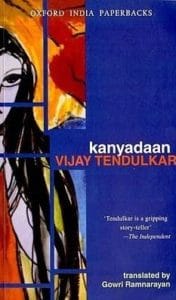 Kanyadaan literally means donation of a daughter (almost always in marriage to the groom’s family by the father of the bride). It is a very important ritual in a Hindu wedding ceremony and often an emotional, private and religious part of the otherwise noisy, very public celebratory event. The concept, held sacred by Hindus, is patriarchal no doubt – with one man (father) handing over his daughter to another (groom). Girls taking up their husband’s family name after marriage (and in some cases, even changing their first name as per the choice of the groom’s family) was a given, until recently. What agency does the girl have in all this? At times none, but many times, especially in modern, educated, progressive households, it is the girl’s decision. As is the case in Devlalikar household of this play. But is it, really? Kanyadaan raises many important questions throughout the play, especially about patriarchy, reformist beliefs, idealism, parenting, casteism – and its widely held preconceived notions, especially by the upper caste folks.
Kanyadaan literally means donation of a daughter (almost always in marriage to the groom’s family by the father of the bride). It is a very important ritual in a Hindu wedding ceremony and often an emotional, private and religious part of the otherwise noisy, very public celebratory event. The concept, held sacred by Hindus, is patriarchal no doubt – with one man (father) handing over his daughter to another (groom). Girls taking up their husband’s family name after marriage (and in some cases, even changing their first name as per the choice of the groom’s family) was a given, until recently. What agency does the girl have in all this? At times none, but many times, especially in modern, educated, progressive households, it is the girl’s decision. As is the case in Devlalikar household of this play. But is it, really? Kanyadaan raises many important questions throughout the play, especially about patriarchy, reformist beliefs, idealism, parenting, casteism – and its widely held preconceived notions, especially by the upper caste folks.
This is a story essentially of father and daughter in the Devalalikar family. It is a progressive, middle class, upper caste family of four; a socialist politician father – Nath, an equally busy and highly placed social worker mother – Seva (which means service, by the way), a dutiful, obedient son (whose occupation and role in the family is obscure) and a sensible, obedient papa’s girl – Jyoti. There is also Arun Athawale – Jyoti’s love interest who becomes her husband in the Second Act 2 – a lower caste (actually a Dalit – an untouchable caste) unemployed youth with poetic inclinations, from a very poor family background and lineage.
The play reveals the ‘democratic’ and liberal atmosphere in the Devalikar family through the interactions between its members. Nath too, misses no opportunity to remind the family and us (the readers) of this. Back in the time the play was written (1983), such liberal, democratic and progressive families in India were far and few. It must have surprised the readers/ audiences then that the upper caste Nath not just supports Jyoti’s decision to marry a Dalit but also becomes the champion of the cause – seeing an opportunity to practice what he had been preaching through his speeches and writings.
Nath’s character, through his long monologues and through the interaction of the other characters, is brilliantly carved. And so is Jyoti’s. The father-daughter relation is lovely and nuanced. Although this is a story of a family, through their characters and relationships, Tendulkar paints a complete socio-political scene of India in front of us. Although I felt enriched and moved reading this play, like other Tendulkar plays I have read, it left me unsatisfied. I thought the other three characters were not as well developed. Jayprakash was insignificant, Seva was ineffective and Arun was dark with no grey shades.
A quick google search for more light on this led me to this balanced critique. Tendulkar had received major criticism especially from Dalits for a ‘dark stereotypical’ portrayal of the Dalit character. There is an incidence in which a shoe was hurled at the writer in criticism of this play.
Tendulkar was awarded Saraswati Sanman for Kanyadaan in 1991. In his speech at the award ceremony, he said (paraphrased);
The work which has been selected for the award is not the story of victory; it is the admission of defeat and intellectual confusion. It gives expression to a deep-rooted malaise and its pains… I have written about my experiences and about what I have seen in others around me. I have been true to all this and have not cheated my generation. I did not attempt to simplify matters and issues for the audience when presenting my plays… You are honoring me with Saraswati Sanman today for a play for which I once had a slipper hurled at me. Perhaps it is the fate of the play to have earned both this honor and that insult. As its creator, I respect both verdicts.

